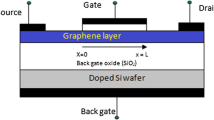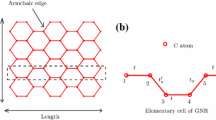Abstract
This article aims at providing a self-contained introduction to theoretical modeling of gate-induced carrier density in graphene sheets. For this, relevant theories are introduced, namely, classical capacitance model (CCM), self-consistent Poisson-Dirac method (PDM), and quantum capacitance model (QCM). The usage of Matlab pdetool is also briefly introduced, pointing out the least knowledge required for using this tool to solve the present electrostatic problem. Results based on the three approaches are compared, showing that the quantum correction, which is not considered by the CCM but by the other two, plays a role only when the metal gate is exceedingly close to the graphene sheet, and that the exactly solvable QCM works equally well as the self-consistent PDM. Practical examples corresponding to realistic experimental conditions for generating graphene pnp junctions and superlattices, as well as how a background potential linear in position can be achieved in graphene, are shown to illustrate the applicability of the introduced methods. Furthermore, by treating metal contacts in the same way, the last example shows that the PDM and the QCM are able to resolve the contact-induced doping and screening potential, well agreeing with the previous first-principles studies.








Similar content being viewed by others
Notes
To be consistent with the pdetool, we name the electric potential as u, while reserve the variable V for the energy band offset (the “on-site energy” in the language of tight-binding formulation).
The mixed type boundary conditions will not be encountered in the present discussion.
If a uniform capacitor (without x dependence) is desired, one needs to assign Neumann boundary conditions at the left and right sides of the oxide boundaries with vanishing surface charge density g=0, which forces the displacement field to be tangential (normal) to the side (top and bottom) boundaries.
Throughout this paper, e=1.60217733×10−19 C is the positive elementary charge.
For the general case of multigated doped graphene, see [20]. The derivation is similar, and the review here is restricted to the simple case of single-gated pristine graphene.
The ratio further diverges to Δn/n C →−100 % at V g =0, but at this axis both n C and Δn vanish, and Δn/n C is strictly speaking undefined.
Note that the spatial profile of the electric potential u(x,z), with the quantum correction on graphene taken into account, does not look too much different compared to the classical solution u 0(x,z), where the graphene layer is assumed to be grounded. The difference of them at z=0, however, is crucial since the latter is always zero, i.e., u 0(x,z=0)=0.
The multigate version of the QCM [20], which requires to compute the self-partial capacitances C lg and C bg due to respectively the local gate and the backgate, can be shown to yield results well agreeing with the PDM.
In [25], α is given by 2.38/ε r possibly because of the slightly different Fermi velocity v F .
References
Castro Neto, A.H., Guinea, F., Peres, N.M.R., Novoselov, K.S., Geim, A.K.: The electronic properties of graphene. Rev. Mod. Phys. 81, 109 (2009)
Das Sarma, S., Adam, S., Hwang, E.H., Rossi, E.: Electronic transport in two-dimensional graphene. Rev. Mod. Phys. 83, 407–470 (2011). Available online: http://link.aps.org/doi/10.1103/RevModPhys.83.407
Novoselov, K.S., Geim, A.K., Morozov, S.V., Jiang, D., Zhang, Y., Dubonos, S.V., Grigorieva, I.V., Firsov, A.A.: Electric field effect in atomically thin carbon films. Science 306(5696), 666–669 (2004)
Huard, B., Sulpizio, J.A., Stander, N., Todd, K., Yang, B., Goldhaber-Gordon, D.: Transport measurements across a tunable potential barrier in graphene. Phys. Rev. Lett. 98, 236803 (2007). Available online: http://link.aps.org/doi/10.1103/PhysRevLett.98.236803
Williams, J.R., DiCarlo, L., Marcus, C.M.: Quantum hall effect in a gate-controlled p–n junction of graphene. Science 317(5838), 638–641 (2007). Available online: http://www.sciencemag.org/content/317/5838/638.abstract
Özyilmaz, B., Jarillo-Herrero, P., Efetov, D., Abanin, D.A., Levitov, L.S., Kim, P.: Electronic transport and quantum hall effect in bipolar graphene p–n–p junctions. Phys. Rev. Lett. 99, 166804 (2007). Available online: http://link.aps.org/doi/10.1103/PhysRevLett.99.166804
Liu, G., Velasco, J.J., Bao, W., Lau, C.N.: Fabrication of graphene p–n–p junctions with contactless top gates. Appl. Phys. Lett. 92(20), 203103 (2008). Available online: http://dx.doi.org/doi/10.1063/1.2928234
Gorbachev, R.V., Mayorov, A.S., Savchenko, A.K., Horsell, D.W., Guinea, F.: Conductance of p–n–p graphene structures with “air-bridge” top gates. Nano Lett. 8(7), 1995–1999 (2008). Available online: http://pubs.acs.org/doi/abs/10.1021/nl801059v
Cheianov, V.V., Fal’ko, V.I.: Selective transmission of Dirac electrons and ballistic magnetoresistance of n–p junctions in graphene. Phys. Rev. B 74(4), 041403 (2006)
Katsnelson, M.I., Novoselov, K.S., Geim, A.K.: Chiral tunnelling and the Klein paradox in graphene. Nat. Phys. 2(9), 620 (2006)
Stander, N., Huard, B., Goldhaber-Gordon, D.: Evidence for Klein tunneling in graphene p–n junctions. Phys. Rev. Lett. 102, 026807 (2009). Available online: http://link.aps.org/doi/10.1103/PhysRevLett.102.026807
Young, A.F., Kim, P.: Quantum interference and Klein tunnelling in graphene heterojunctions. Nat. Phys. 5(3), 222–226 (2009)
Nam, S.-G., Ki, D.-K., Park, J.W., Kim, Y., Kim, J.S., Lee, H.-J.: Ballistic transport of graphene pnp junctions with embedded local gates. Nanotechnology 22(41), 415203 (2011)
Guo, J., Yoon, Y., Ouyang, Y.: Gate electrostatics and quantum capacitance of graphene nanoribbons. Nano Lett. 7(7), 1935–1940 (2007). Available online: http://pubs.acs.org/doi/abs/10.1021/nl0706190
Fernández-Rossier, J., Palacios, J.J., Brey, L.: Electronic structure of gated graphene and graphene ribbons. Phys. Rev. B 75, 205441 (2007). Available online: http://link.aps.org/doi/10.1103/PhysRevB.75.205441
Fang, T., Konar, A., Xing, H., Jena, D., Carrier statistics and quantum capacitance of graphene sheets and ribbons. Appl. Phys. Lett. 91(9), 092109 (2007). Available online: http://link.aip.org/link/?APL/91/092109/1
Shylau, A.A., Kłos, J.W., Zozoulenko, I.V.: Capacitance of graphene nanoribbons. Phys. Rev. B 80, 205402 (2009). Available online: http://link.aps.org/doi/10.1103/PhysRevB.80.205402
Andrijauskas, T., Shylau, A.A., Zozoulenko, I.V.: Thomas-Fermi and Poisson modeling of gate electrostatics in graphene nanoribbon. Liet. Fiz. Zh. 52(1), 63–69 (2012)
Luryi, S.: Quantum capacitance devices. Appl. Phys. Lett. 52(6), 501–503 (1988). Available online: http://link.aip.org/link/?APL/52/501/1
Liu, M.-H.: Theory of carrier density in multigated doped graphene sheets with quantum correction. Phys. Rev. B 87, 125427 (2013). Available online: http://link.aps.org/doi/10.1103/PhysRevB.87.125427
Liu, M.-H., Richter, K.: Efficient quantum transport simulation for bulk graphene heterojunctions. Phys. Rev. B 86, 115455 (2012). Available online: http://link.aps.org/doi/10.1103/PhysRevB.86.115455
Shytov, A.V., Rudner, M.S., Levitov, L.S.: Klein backscattering and Fabry-Pérot interference in graphene heterojunctions. Phys. Rev. Lett. 101, 156804 (2008). Available online: http://link.aps.org/doi/10.1103/PhysRevLett.101.156804
Krueckl, V., Richter, K.: Bloch-Zener oscillations in graphene and topological insulators. Phys. Rev. B 85, 115433 (2012). Available online: http://link.aps.org/doi/10.1103/PhysRevB.85.115433
Khomyakov, P.A., Giovannetti, G., Rusu, P.C., Brocks, G., van den Brink, J., Kelly, P.J.: First-principles study of the interaction and charge transfer between graphene and metals. Phys. Rev. B 79, 195425 (2009). Available online: http://link.aps.org/doi/10.1103/PhysRevB.79.195425
Khomyakov, P.A., Starikov, A.A., Brocks, G., Kelly, P.J., Nonlinear screening of charges induced in graphene by metal contacts. Phys. Rev. B 82, 115437 (2010). Available online: http://link.aps.org/doi/10.1103/PhysRevB.82.115437
Partial differential equation toolboxTM User’s guide, Matlab 2012a ed., The MathWorks, Inc. (2012)
Rashba, E.I.: Properties of semiconductors with an extremum loop. I. Cyclotron and combinational resonance in a magnetic field perpendicular to the plane of the loop. Sov. Phys., Solid State 2, 1109 (1960)
Bychkov, Y.A., Rashba, E.I.: Properties of a 2d electron-gas with lifted spectral degeneracy. JETP Lett. 39, 78 (1984)
Gmitra, M., Konschuh, S., Ertler, C., Ambrosch-Draxl, C., Fabian, J.: Band-structure topologies of graphene: spin-orbit coupling effects from first principles. Phys. Rev. B 80, 235431 (2009). Available online: http://link.aps.org/doi/10.1103/PhysRevB.80.235431
Abdelouahed, S., Ernst, A., Henk, J., Maznichenko, I.V., Mertig, I.: Spin-split electronic states in graphene: effects due to lattice deformation, Rashba effect, and adatoms by first principles. Phys. Rev. B 82, 125424 (2010). Available online: http://link.aps.org/doi/10.1103/PhysRevB.82.125424
Yamakage, A., Imura, K.-I., Cayssol, J., Kuramoto, Y.: Interfacial charge and spin transport in \({\mathbb{z}}_{2}\) topological insulators. Phys. Rev. B 83, 125401 (2011). Available online: http://link.aps.org/doi/10.1103/PhysRevB.83.125401
Tian, H.Y., Yang, Y.H., Wang, J.: Interfacial charge current in a magnetised/normal graphene junction. Eur. Phys. J. B 85(8) (2012)
Yamakage, A., Imura, K.I., Cayssol, J., Kuramoto, Y.: Spin-orbit effects in a graphene bipolar pn junction. EPL 87(4) (2009)
Liu, M.-H., Bundesmann, J., Richter, K.: Spin-dependent Klein tunneling in graphene: role of Rashba spin-orbit coupling. Phys. Rev. B 85, 085406 (2012). Available online: http://link.aps.org/doi/10.1103/PhysRevB.85.085406
Rataj, M., Barnaś, J.: Graphene p–n junctions with nonuniform Rashba spin-orbit coupling. Appl. Phys. Lett. 99(16), 162107 (2011). Available online: http://dx.doi.org/10.1063/1.3641873
Sánchez-Barriga, J., Varykhalov, A., Scholz, M.R., Rader, O., Marchenko, D., Rybkin, A., Shikin, A.M., Vescovo, E.: Chemical vapour deposition of graphene on Ni(111) and Co(0001) and intercalation with Au to study Dirac-Cone formation and Rashba splitting. In: Diamond and Related Materials, 19, no. 7–9, pp. 734–741, 20th European Conference on Diamond, Diamond-Like Materials, Carbon Nanotubes and Nitrides, Athens, Greece, 6–10 Sep. 2009 (2009)
Xia, J., Chen, F., Li, J., Tao, N.: Measurement of the quantum capacitance of graphene. Nat. Nanotechnol. 4(8), 505–509 (2009)
Dröscher, S., Roulleau, P., Molitor, F., Studerus, P., Stampfer, C., Ensslin, K., Ihn, T.: Quantum capacitance and density of states of graphene. Appl. Phys. Lett. 96(15), 152104 (2010). Available online: http://link.aip.org/link/?APL/96/152104/1
Ponomarenko, L.A., Yang, R., Gorbachev, R.V., Blake, P., Mayorov, A.S., Novoselov, K.S., Katsnelson, M.I., Geim, A.K.: Density of states and zero landau level probed through capacitance of graphene. Phys. Rev. Lett. 105, 136801 (2010). Available online: http://link.aps.org/doi/10.1103/PhysRevLett.105.136801
Martin, J., Akerman, N., Ulbricht, G., Lohmann, T., Smet, J.H., Von Klitzing, K., Yacoby, A.: Observation of electron-hole puddles in graphene using a scanning single-electron transistor. Nat. Phys. 4(2), 144–148 (2008)
Xu, H., Zhang, Z., Peng, L.-M.: Measurements and microscopic model of quantum capacitance in graphene. Appl. Phys. Lett. 98(13), 133122 (2011). Available online: http://link.aip.org/link/?APL/98/133122/1
Rickhaus, P., Maurand, R., Liu, M.-H., Weiss, M., Richter, K., Schönenberger, C.: Ballistic interferences in suspended graphene. March (2013, unpublished)
Acknowledgements
The author thanks T. Fang and D. Jena for their illuminating suggestions, F.-X. Schrettenbrunner, J. Eroms, P. Rickhaus, and R. Maurand for sharing their experimental viewpoints, and V. Krueckl and K. Richter for valuable discussions. Financial supports from Alexander von Humboldt Foundation (former part of the work) and Deutsche Forschungsgemeinschaft within SFB 689 (present) are gratefully acknowledged.
Author information
Authors and Affiliations
Corresponding author
Rights and permissions
About this article
Cite this article
Liu, MH. Gate-induced carrier density modulation in bulk graphene: theories and electrostatic simulation using Matlab pdetool. J Comput Electron 12, 188–202 (2013). https://doi.org/10.1007/s10825-013-0456-9
Published:
Issue Date:
DOI: https://doi.org/10.1007/s10825-013-0456-9




